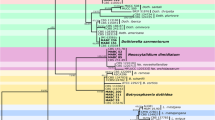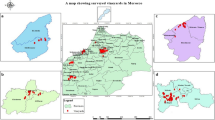Abstract
This study investigated the prevalence and identity of botryosphaeriaceous dieback pathogens in necrotic grapevines tissues in New Zealand vineyards, and other woody hosts growing nearby. The presumptive identities of the isolates by conidial and cultural morphology were confirmed with ITS sequence data as Neofusicoccum australe, N. luteum, N. parvum and Diplodia seriata. They were isolated predominantly from necrotic stems of grapevine and other hosts, but also from leaves, flowers and wood debris of grapevines. Inoculation with conidia and mycelium of multiple isolates of each species onto excised and attached green shoots and trunks of five grapevine varieties, Cabernet sauvignon, Chardonnay, Pinot noir, Riesling, and Sauvignon blanc, showed that all varieties became infected to a similar extent. All species except D. seriata were pathogenic, irrespective of the host source, with N. luteum being the most and D. mutila the least pathogenic (P < 0.05). On trunks, N. parvum caused cankers and the other pathogenic species caused die-back when the inoculated vines became winter-dormant. Conidia were produced from green shoot lesions and die-back wood, which indicates potential inoculum sources for vineyard infection.






Similar content being viewed by others
References
Alves, A., Correia, A., Luque, J., & Phillips, A. (2004). Botryosphaeria corticola, sp. nov. on Quercus species, with notes and description of Botryosphaeria stevensii and its anamorph, Diplodia mutila. Mycologia, 96(3), 598–613.
Amponsah, N. T., Jones, E. E., Ridgway, H. J., & Jaspers, M. V. (2008). Production of Botryosphaeria species conidia using grapevine green shoots. New Zealand Plant Protection, 61, 301–305.
Amponsah, N. T., Jones, E. E., Ridgway, H. J., & Jaspers, M. V. (2009). Rainwater dispersal of Botryosphaeria conidia from infected grapevines. New Zealand Plant Protection, 62, 228–233.
Castillo-Pando, M., Somers, A., Green, C. D., Priest, M., & Sriskanthades, M. (2001). Fungi associated with dieback of Semillon grapevines in the Hunter Valley of New South Wales. Australasian Plant Pathology, 30(1), 59–63.
Crous, P. W., Slippers, B., Wingfield, M. J., Rheeder, J., Marasas, W. F. O., Philips, A. J. L., et al. (2006). Phylogenetic lineages in the Botryosphaeriaceae. Studies in Mycology, 55, 235–253.
Cunnington, J. H., Priest, M. J., Powney, R. A., & Cother, N. J. (2007). Diversity of Botryosphaeria species on horticultural plants in Victoria and New South Wales. Australasian Plant Pathology, 36, 157–159.
Denman, S., Crous, P. W., Taylor, J. E., Kang, J.-C., Pascoe, I., & Wingfield, M. J. (2000). An overview of the taxonomic history of Botryosphaeria, and a re-isolation of its anamorphs based on morphology and ITS rDNA phylogeny. Studies in Mycology, 43, 129–140.
Epstein, L., Kaur, S., & Van der Gheynst, J. S. (2008). Botryosphaeria-related dieback and control investigated in non-coastal California grapevines. California Agriculture, 62(4), 161–166.
Larignon, P., & Dubos, B. (2001). The villainy of black dead arm. Wines & Vines, 82, 86–89.
Larignon, P., Fulchic, R., Cere, L., & Dubos, B. (2001). Observations on black dead arm in French vineyards. Phytopathologia Mediterranean, 40, 336–342.
Luque, J., Martos, S., & Phillips, A. J. L. (2005). Botryosphaeria viticola sp. nov. on grapevines: a new species with a Dothiorella anamorph. Mycologia, 97(5), 1111–1121.
Martos, S., Andolfi, A., Luque, J., Mugnai, L., Surico, G., & Evidente, A. (2008). Production of phytotoxic metabolites by five species of Botryosphaeriaceae causing decline on grapevines, with special interest in the species Neofusicoccum luteum and N. parvum. European Journal of Plant Pathology, 121, 451–461.
McDonald, V. T., Lynch, S. C., & Eskalen, A. (2009). Identification and pathogenicity of Botryosphaeria species associated with avocado branch dieback and trunk canker in California. Phytopathology, 99, S81. (Abst).
Munkvold, G. P., & Marois, J. J. (1995). Factors associated with variation in susceptibility of grapevine pruning wound to infection by Eutypa lata. Phytopathology, 85, 249–256.
Pennycook, S. R., & Samuels, G. J. (1985). Botryosphaeria and Fusicoccum species associated with ripe fruit rot of Actinidia deliciosa (kiwifruit) in New Zealand. Mycotaxon, 24, 445–458.
Phillips, A. J. L. (2000). Excoriose, cane blight and related diseases of grapevine: a taxonomic review of the pathogens. Phytopathologia Mediterranea, 39, 341–356.
Phillips, A. J. L. (2002). Botryosphaeria species associated with diseases of grapevines in Portugal. Phytopathologia Mediterranea, 41, 3–18.
Phillips, A. J. L., Alves, A., Correia, A., & Luque, J. (2005). Two new species of Botryosphaeria with brown, 1-septate ascospores and Dothiorella anamorphs. Mycologia, 97, 513–529.
Prusky, D., & Plumbley, R. A. (1992). Quiescent infections of Colletotrichum in tropical and subtropical fruits. In J. A. Bailey & M. J. Jeger (Eds.), Biology, pathology and control (pp. 289–307). Wallingford: C.A.B. International.
Sammonds, J., Billones, R., Rocchetti, M., Ridgway, H. J., & Jaspers, M. V. (2009). Survey of Blueberry farms for Botryosphaeria dieback and crown rot pathogens. New Zealand Plant Protection, 62, 238–242.
Slippers, B., Crous, P. W., Denman, S., Coutinho, T. A., Wingfield, B. D., & Wingfield, M. J. (2004). Combined multiple gene genealogies and phenotypic characters differentiate several species previously identified as Botryosphaeria dothidea. Mycologia, 96(1), 83–101.
Stanosz, G. R., Swart, W. J., & Smith, D. R. (1998). Similarity between fungi identified as Diplodia pinea f. sp. cupressi in Israel and Botryosphaeria stevensii or Diplodia mutila on Juniperus in the United States. European Journal of Forest Pathology, 28, 33–42.
Sutton, T. B. (1990). White rot. In A. L. Jones & H. S. Aldwinckle (Eds.), Compendium of apple and pear diseases (pp. 16–18). USA: American Phytopathological Society Press St. Paul.
Tamura, K., Dudley, J., Nei, M., & Kumar, S. (2007). MEGA4: Molecular Evolutionary Genetics Analysis (MEGA) software version 4.0. Molecular Biology and Evolution, 24, 1596–1599.
Taylor, A., St, J., Hardy, G. E., Wood, P., & Burgess, T. (2005). Identification and pathogenicity of Botryosphaeria species associated with grapevine decline in Western Australia. Australasian Plant Pathology, 34(2), 187–195.
Úrbez-Torres, J. R., & Gubler, W. D. (2009). Pathogenicity of Botryosphaeriaceae species isolated from grapevine cankers in California. Plant Disease Research, 93(6), 584–592.
Úrbez-Torres, J. R., Leavitt, G. M., Voegel, T. M., & Gubler, W. D. (2006). Identification and distribution of Botryosphaeria spp. associated with grapevine cankers in California. Plant Disease, 90(12), 1490–1503.
Úrbez-Torres, J. R., Adams, P., Kamas, J., & Gubler, W. D. (2009). Identification, incidence, and pathogenicity of fungal species associated with grapevine dieback in Texas. American Journal of Enology and Viticulture, 60(4), 497–507.
Úrbez-Torres, J. R., Battany, M., Bettiga, L. J., Gispert, C., McGourty, G., Roncoroni, J., et al. (2010). Botryosphaeriaceae species spore-trap** studies in California Vineyards. Plant Disease, 94(6), 717–724.
van Niekerk, J. M., Crous, P. W., Groenewald, J. Z., Fourie, P. H., & Halleen, F. (2004). DNA phylogeny, morphology and pathogenicity of Botryosphaeria species on grapevines. Mycologia, 96(4), 781–798.
White, T. J., Bruns, T., Lee, S., & Taylor, J. (1990). Amplification and direct sequencing of fungal ribosomal RNA genes for phylogenetics. In M. A. Innis, D. H. Gelfand, J. J. Shinsky, & T. White (Eds.), PCR protocols: A guide to methods and applications (pp. 315–322). San Diego: Academic.
Acknowledgement
We are grateful to New Zealand Winegrowers and Lincoln University for funding this research and to the many grapegrowers who provided us with the symptomatic plant samples.
Author information
Authors and Affiliations
Corresponding author
Rights and permissions
About this article
Cite this article
Amponsah, N.T., Jones, E.E., Ridgway, H.J. et al. Identification, potential inoculum sources and pathogenicity of botryosphaeriaceous species associated with grapevine dieback disease in New Zealand. Eur J Plant Pathol 131, 467–482 (2011). https://doi.org/10.1007/s10658-011-9823-1
Accepted:
Published:
Issue Date:
DOI: https://doi.org/10.1007/s10658-011-9823-1




